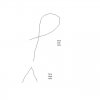I was talking to Sapwood at lunch time about making M&T's and the marking out of joints etc and I wondered in this day of machine cut joints and incra jigs etc, how many of us still by habit and need I might add, mark the face side and face edge with the traditional marks immediately after preping and then keep them (or try to) through the life of the piece. I was taught that in wood shop back in school 30 odd years ago and still do it today.
You are using an out of date browser. It may not display this or other websites correctly.
You should upgrade or use an alternative browser.
You should upgrade or use an alternative browser.
- Status
- Not open for further replies.
Don't usually make those marks, but I do mark "top, bot, L side R side, back, etc" on some projects. Also use V shape mark when edge joining boards.
Yes I remember that from wood shop too. Never used it much. Too much trouble, and I kept cutting off my marks, so I gave up on that one.
Yes I remember that from wood shop too. Never used it much. Too much trouble, and I kept cutting off my marks, so I gave up on that one.
Well I've got marks and writing all over my little project. I made them up as I went except for a few standards like the triangle and LS, RF, etc. :lol:
And since the project (shop table) was made of pine I just wiped the poly right over them. So they will be preserved for future generations :roll:
Sapwood
And since the project (shop table) was made of pine I just wiped the poly right over them. So they will be preserved for future generations :roll:
Sapwood
Roger, that's a good point. Leaving the hand markings and layout lines adds to handcut dovetails. It's a rush to see the layout marks on the dovetails on an old antique piece of furniture. I always mark the pieces, usually F=Front, T=Top, B=Back, etc. I usually just stick a piece of masking tape on the wood and write on that instead of directly on the wood, saves getting the marks/graphite out of the wood.
One simple trick I found for marking. Use ordinary white chalk. I can mark all I want (Front, Back, Side whatever) and I don't have to worry about sanding out the pencil lines when done! (Kinda hard marking up DT cutlines though!)
Plus. When the little neighborhood helpers arrive, I can just take a peice of chalk out of the box and send them to the driveway!:lol: :lol: :lol:
Wayne
Plus. When the little neighborhood helpers arrive, I can just take a peice of chalk out of the box and send them to the driveway!:lol: :lol: :lol:
Wayne
The trad marks are more machining and marking rather than whether the piece is front left etc. The edge mark points towards the reference face so even if the face mark gets sanded off you know which was your ref face. An "X" on the edge doesn't tell you this. Looking for the the mark when machining is easier too - when machining a T&G for instance, if the face mark is on the router table for each piece when it's cut then they will line up regardless of differeing thickness. When marking out the shoulders of a M&T if the stock of the square is always on either mark then the layout lines will always meet at the end regardless of whether the sides are exactely parallel. I mark them as soon as I have done the jointer work - plane the face, plane the edge at right angles and mark them. Then to the planer. I don't do the flip flop thing that some recommend just for the reason of not losing my reference. if the planer knives or table are not perfectly parallel then your hard earned jointer work is all for nothing, but if you still have the ref marks then all your subsequent layouts will still work. Certainly over the years I have found that it's a good habit to get into. Just the ramblings of old school...:lol:
Ditto for me like Dave. Letters to represent. F for front, T for top, etc. Unfortunately, I still screw up and miscut the stuff at times.
I have a couple of chests that my greatgrandfather made. He also left his construction marks in various places that are not readily noticable. I really like seeing his scratch marks still there. No matter what you use to make sure piece one gets jointed to piece two, the maker's marks provide a certain warm flavor to hand made projects. Quite often these marks are what makes the finished piece authentic... at least to future generations. I may use an awl, a pencil, a nail, or a small knife that I keep in my pocket. My wife makes me sign each piece with a wood burner. So, if we're going to make distinguished pieces, let's make them really distinct with both our signatures and our construction marks, that is if the marks don't inhibit the finished beauty.
We like that idea of preserving the construction marks. One of the reasons we are attracted to woodworking is the thought of creating works that can be passed down generation to generation. The marks would only enhance that generational continuity.
Duke & Irene
Duke & Irene
- Status
- Not open for further replies.
LATEST FOR SALE LISTINGS
-
-
Graco 395 FinishPro air assisted airless sprayer for sale
- Started by RobH
- Replies: 1
-
-
-

